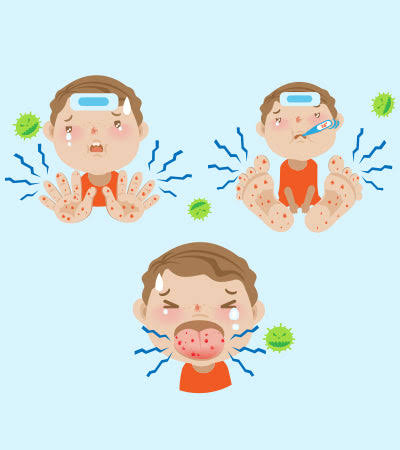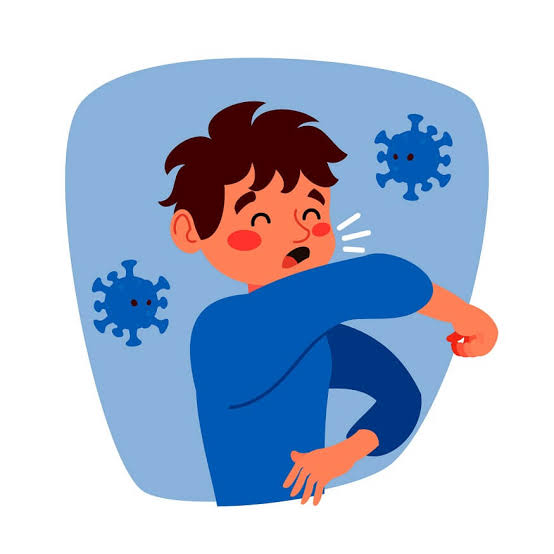Hand, Foot, and Mouth Disease (HFMD) is a prevalent viral infection that mostly affects young children but can also strike adults. Sores on the hands, feet, and mouth are some of the distinctive symptoms of this highly contagious disease. The definition, pathology, causes, risk factors, signs and symptoms, investigations, general management, prevention, and differential diagnosis of HFMD will all be discussed in this beginner’s guide. In addition, we will investigate the position that homeopathy takes in the treatment of this condition and provide insights into the potential advantages of it.

What is Hand, Foot, Mouth Disease?
Enteroviruses are a group of viruses that cause HFMD, which is a viral infection that spreads quickly. Enterovirus 71 and Coxsackievirus A16 are the most prevalent culprits. Although anyone can get this illness, it mostly affects children under the age of 5. The characteristic sores that appear on the hands, feet, and inside the mouth are what give the condition its name, “Hand, Foot, Mouth Disease.”
The Pathology of Hand, Foot, Mouth Disease
To comprehend how HFMD affects the body, it is essential to comprehend its pathology. The virus spreads to the throat, intestines, and other body parts after entering through the mouth or nose. Once the virus establishes itself, it causes inflammation, which results in the typical signs and symptoms of the disease.
The Causes of Hand, Foot, Mouth Disease
Viral infection is the most common cause of HFMD, with the most common viruses being Coxsackievirus A16 and Enterovirus 71. The virus is spread by direct contact with the saliva, nasal secretions, or feces of an infected person. When an infected person coughs or sneezes, it also has the potential to spread through respiratory droplets. Transmission may be facilitated by close contact with infected individuals or contaminated surfaces.
The Risk Factors of Hand, Foot, Mouth Disease
The risk of contracting HFMD can be raised by a number of factors, including:
1. Age: The developing immune systems of young children make them more susceptible to HFMD.
2. Crowded Environments: The virus thrives in environments like daycare centers and schools where children are close to one another.
3. Poor hygiene: Infections can become more likely if proper hand washing and sanitation practices aren’t followed.
4. Variations Based on the Season: HFMD is more prevalent during the warmer months.
The Signs and Symptoms of Hand, Foot, Mouth Disease
For early diagnosis and treatment, it is essential to recognize HFMD symptoms:
1. Fever: A high fever is often the first sign of HFMD.
2. Throat Soreness: The throat may develop painful sores that make swallowing difficult.
3. Mouth Sores: Inside the mouth, small, painful ulcers can appear.
4. Skin Rash: On the hands, feet, and occasionally the buttocks, red spots and blisters may appear.
5. Irritability: Discomfort can cause children with HFMD to become irritable.
Investigations for Hand, Foot, Mouth Disease
In order to determine the severity of the infection and confirm the diagnosis of HFMD, healthcare professionals may conduct certain investigations when the condition is suspected. These investigations might look into:
1. Physical Test: A comprehensive physical examination to look for recognizable symptoms like mouth sores and skin rashes.
2. Swab of the Throat: The virus can be identified with a throat swab.
3. Stool Sample: To find the virus, a stool sample may be taken in some cases.
4. Blood tests: Blood tests can check for complications and help determine the severity of the infection.
General Management of Hand, Foot, Mouth Disease
The primary goals of HFMD treatment are symptom relief and avoiding complications. Some general approaches to management are as follows:
1. Hydration: If swallowing is painful, encourage frequent sips of water or oral rehydration solutions to stay hydrated.
2. Fever Reduction: A healthcare professional may suggest fever-reducing over-the-counter medications.
3. Pain Management: Medication for pain management can reduce the discomfort brought on by mouth sores and skin rashes.
4. Isolation: In order to stop the virus from spreading, infected individuals should be kept apart.
5. Hygiene: Good hygiene practices include washing one’s hands frequently, especially before eating and after using the bathroom.
6. Rest: The body needs to rest to fight off the infection.
Prevention of Hand, Foot, Mouth Disease
It is essential to prevent HFMD, particularly in settings where children gather. Preventative measures include:
1. Hand washing: Show children how to properly wash their hands using soap and water for at least 20 seconds.
2. Contact: Encourage children to avoid coming into close contact with infected people.
3. Clean and Disinfect: Clean and disinfect toys, surfaces, and other items that are frequently touched on a regular basis.
4. Isolation: Infected children should stay at home from daycare or school until they are no longer infectious.
5. Vaccination: Some research is being done in this area despite the fact that there is no specific vaccine for HFMD.
Differential Diagnosis for Hand, Foot, Mouth Disease
It is essential to distinguish HFMD from other conditions that share symptoms. These may include:
1. Herpangina: This viral infection typically only affects the hands and feet but can cause fever and mouth ulcers.
2. Chickenpox: HFMD-like rashes can be caused by chickenpox (Varicella), but they typically affect the entire body.
3. Scarlet Fever: This is a bacterial infection that can cause a rash and a fever, but it rarely results in mouth sores.
The Role of Homeopathy in Treating Hand, Foot, Mouth Disease
Now that we have that out of the way, let’s get into the subject of homeopathy and how it might be used to treat HFMD. Homeopathy is a holistic approach to medicine that encourages the body’s own natural healing processes by administering highly diluted substances.
Common Homeopathic Remedies for HFMD
Although each homeopathic remedy is unique, the following are some common ones that may be considered for HFMD:
1. Belladonna: Belladonna is taken for a sore throat that makes swallowing painful and makes the throat feel tigh. It’s deteriorated by contact, clamor, drafts, and sleeping.
2. Hepar Sulphuris Calcareum (Hepar Sulph): Hepar Sulph is used to treat swallowing discomfort caused by a foreign object or splinter in the throat. Touch and cold exacerbate throat pain, and warmth and eating provide relief.
3. Phytolacca: Phytolacca is suggested for HFMD with nerve pain in the tongue that reaches the ears. It also works well when the tonsils and soft palate are swollen, the throat feels rough, narrow, and hot, and so on. The symptoms get worse in cold weather and get better with rest and dry weather.
4. Mercurius Solubilis (Mercurius): Mercurius is used to treat mouth blisters and sores that bleed and hurt. It is recommended for HFMD symptoms that are worse at night, when the weather is wet or damp, or when you lie on your right side. The condition is also exacerbated by warm environments and sweat.
5. Borax: Borax is suitable for HFMD with aphthae (ulcers) that bleed upon touch and eating. It’s more effective in warm weather and less so in cold weather, providing relief from pressure and in the evening.
6. Graphites: HFMD with burning blisters on the tongue, salivation, and a musty odor in the mouth is a good candidate for graphites. The symptoms get worse at night and when it gets warm, but they get better in the dark and when you wrap yourself warmly.
7. Natrum Muriaticum (Natrum Mur): Natrum Mur is used to treat HFMD which causes stinging blisters on the skin filled with watery fluid. When lying down and in a warm room, symptoms get worse, but they get better outdoors and when you take a cold bath. Depending on the condition, various potencies are available, ranging from 12C to 1M and 10M.
8. Apis Mellifica: This remedy is frequently used for conditions that cause redness, burning, and stinging. It might help skin rashes caused by HFMD.
9. Rhus Tox: Rhus Tox may be considered if the skin rash in HFMD is itchy and aggravated by scratching.

Consulting a Homeopathic Practitioner
If you or your child is considering homeopathic treatment for HFMD, it’s crucial to consult a qualified homeopathic practitioner. They will conduct a thorough assessment of the individual’s symptoms and overall health before prescribing any remedies. Homeopathy is a personalized approach, and the choice of remedy can vary from person to person.
Conclusion: Empowering Yourself with Knowledge
The viral illness known as “Hand, Foot, and Mouth Disease” mostly affects children but can affect anyone. To safeguard yourself and those you care about, it is essential to figure out its symptoms, causes, and preventative measures. You can confidently navigate HFMD and promote the well-being of those in your care by remaining informed and taking proactive measures.
Reach out to us for a Consultation
For any queries, reach out to us at contact@homeopathic.ai
This blog is for information purposes. It’s crucial to note that while homeopathy is a centuries-old practice with many adherents worldwide, always consult a qualified homeopath or medical professional before initiating any treatment.



